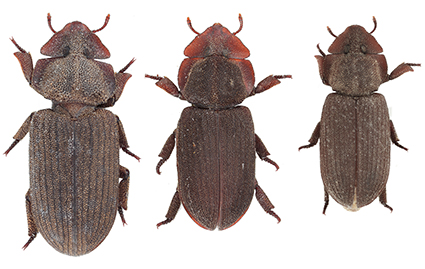Abstract
The enigmatic tenebrionid genera Rondoniella Kaszab, 1970 and Durandius Kaszab, 1970 are briefly reviewed and diagnosed. Rondoniella hosoishii sp. nov. is described based on specimens collected from a nest of the arboreal ant Crematogaster sewardi in Cambodia. Because of where R. hosoishii sp. nov. was collected and its specialized morphology, the members of Rondoniella and its close relative Durandius are considered to be myrmecophilous, as was suggested in the original description. They also have reduced mouthparts, which are unknown in other tenebrionids, and they might receive food from ants by trophallaxis.
References
Blaimer, B.B. (2012) A subgeneric revision of Crematogaster and discussion of regional species-groups (Hymenoptera: Formicidae). Zootaxa, 3482, 47–67.
Ferrer, J. & Moragues, G. (2000) Contribution á l’etude des Cnemmeplatiini. Description de Rondoniella bremeri n. sp. du Laos (Coleoptera, Tenebrionidae). Nouvelle Revue d'Entomologie, New Series, 17 (2), 99–105.
Hölldobler, B. & Kwapich, C.L. (2022) The guests of ants. Harvard University Press, Cambridge, Massachusetts, 576 pp. https://doi.org/10.4159/9780674276451
Kaszab, Z. (1970) Fünf neue Tenebrioniden aus Asien (Coleoptera). Entomologische Arbeiten aus dem Museum Georg Frey, 21, 112–120.
Kistner, D.H. (1982) The social insects’ bestiary. In: Hermann, H.R. (Ed.), Social insects. Vol. III. Academic Press, New York, pp. 1–244. https://doi.org/10.1016/B978-0-12-342203-3.50008-4
Komatsu, T., Maruyama, M., Hattori, M. & Itino, T. (2018) Morphological characteristics reflect food sources and degree of host ant specificity in four Myrmecophilus crickets. Insectes Sociaux, 65, 47–57. https://doi.org/10.1007/s00040-017-0586-3
Lawrence, T.F. & Britton, E.B. (1991) Coleoptera (Beetles). In: CSIRO Division of Entomology (Ed.), Insects of Australia: A Textbook for Students and Research workers, Second Edition. Vol. 2. Melbourne University Press. Carlton, Victoria, pp. 543–683.
Maruyama, M. (2004) A permanent slide pinned under a specimen. Elytra, 32 (2), 276.
Maruyama, M. (2010) A new genus and species of myrmecophilous aphodiine beetle inhabiting the myrmecophytic epiphyte Platycerium sp. (Polypodiaceae) in the Bornean rainforest canopy. Zookeys, 34, 49–54. https://doi.org/10.3897/zookeys.34.281
Maruyama, M., Bartolozzi, L., Inui, Y., Tanaka, H., Hyodo, F., Shimizu-Kaya, U., Takematsu, Y., Hishi, T. & Itioka, T. (2014) A new genus and species of myrmecophilous brentid beetle (Coleoptera: Brentidae) inhabiting the myrmecophytic epiphytes in the Bornean rainforest canopy. Zootaxa, 3786 (1), 73–78. https://doi.org/10.11646/zootaxa.3786.1.5
Matthews, E.G. & Bouchard, P. (2008) Tenebrionid Beetles of Australia. Australian Biological Resources Study, Canberra, viii + 398 pp.
Parker, J. (2016) Myrmecophily in beetles (Coleoptera): evolutionary patterns and biological mechanisms. Myrmecological News, 22, 65–108.
Tschinkel, W.R. & Doyen, J.T. (1980) Comparative anatomy of the defensive glands, ovipositor and female genital tubes of tenebrionid beetles (Coleoptera). International Journal of Insect Morphology and Embryology, Oxford, 9, 321–368. https://doi.org/10.1016/0020-7322(80)90009-4


